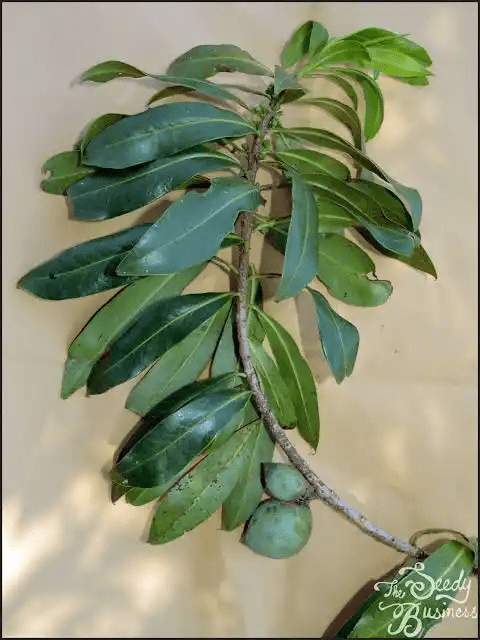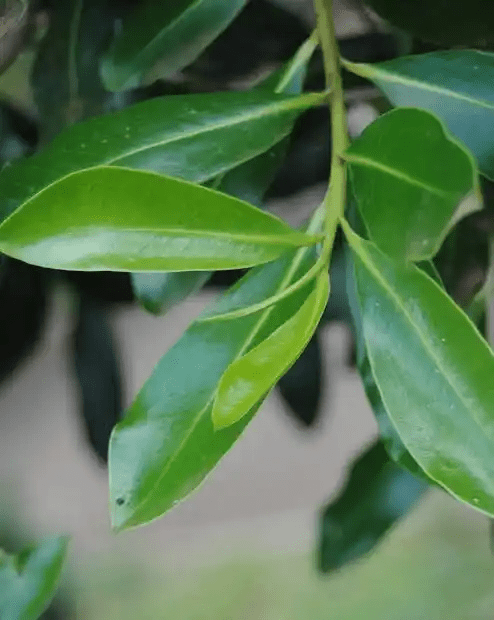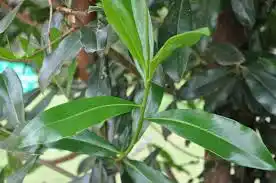Warburgia ugandensis, commonly known as the Ugandan Greenheart or Pepper Bark tree, is a species native to the eastern and central regions of Africa, including countries like Uganda, Kenya, Tanzania, and Ethiopia. This tree belongs to the Canellaceae family and is highly valued for its medicinal properties, particularly in traditional African medicine systems.
The Ugandan Greenheart is a medium-sized evergreen tree that can reach heights of up to 20 meters. It has a dense, rounded crown with glossy, dark green leaves that are lance-shaped and emit a peppery aroma when crushed or bruised, hence its name “Pepper Bark tree.” The bark of this tree is one of its most sought-after parts due to its medicinal properties.
In traditional African medicine, various parts of the Ugandan Greenheart tree, including the bark, leaves, and roots, are used to prepare herbal remedies. The bark, in particular, contains bioactive compounds believed to have potent antimicrobial, anti-inflammatory, and analgesic properties. It has been used to treat a range of ailments, including respiratory issues like coughs and bronchitis, digestive problems, and as a remedy for fever and pain. Additionally, it’s believed to have properties that support general wellness and immune function.
However, it’s important to note that while the tree has a long history of traditional medicinal use, scientific studies on its medicinal properties are ongoing, and more research is needed to validate its effectiveness and safety in treating various health conditions.
Due to its medicinal significance, the Ugandan Greenheart tree faces threats from overharvesting for its bark and other parts, leading to conservation concerns. Efforts are being made to promote sustainable harvesting practices and protect the species to ensure its preservation for future generations.
Beyond its medicinal uses, the Ugandan Greenheart tree also contributes to the ecosystem as part of the native flora in the African region, providing habitat and food for wildlife.
The cultural and medicinal importance of Warburgia ugandensis, the Ugandan Greenheart, highlights the rich biodiversity of African plant species and their valuable contributions to traditional medicine and local ecosystems.
The Botanical Description of Warburgia ugandensis
1. Life: Warburgia ugandensis, commonly known as the Ugandan Greenheart or Green-bark tree, is a magnificent evergreen species that belongs to the Canellaceae family. This tree is characterized by a tall, straight trunk, reaching heights of up to 30 meters, with a dense and symmetrical crown of foliage. The bark is a distinguishing feature, displaying a vibrant green color, giving the tree its common name.
2. Leaves: The leaves of Warburgia ugandensis are simple, opposite, and lanceolate in shape. They have a glossy dark green color, contributing to the overall lush appearance of the tree. The arrangement of leaves along the branches enhances the tree’s aesthetic appeal.
3. Flowers: The tree produces small, inconspicuous flowers that are typically arranged in clusters. While not known for their ornamental value, these flowers play a crucial role in the reproductive cycle of the tree, leading to the development of its distinctive fruits.
4. Fruits: The fruits of Warburgia ugandensis are berry-like structures that mature to a deep purple or black color. These fruits are an important food source for various wildlife species. The seeds within the fruits contribute to the tree’s reproduction, ensuring its continued presence in its natural habitat.
The Geographic Distribution of Warburgia ugandensis
1. Native Regions: Warburgia ugandensis is native to several countries in East Africa, including Uganda, Kenya, Tanzania, and Rwanda. It thrives in a range of habitats, from mountainous regions to lowland forests, showcasing its adaptability to diverse environmental conditions.
2. Preferred Climate: This species is well-suited to tropical and subtropical climates, where it can be found in both montane and lowland rainforests. The tree’s distribution is influenced by factors such as temperature, rainfall, and elevation.
3. Habitat Diversity: Warburgia ugandensis exhibits a preference for well-drained soils and is often found in areas with good moisture availability. It is a key component of the biodiversity in the regions it inhabits, contributing to the overall health of the ecosystems it occupies.
The Chemical Composition of Warburgia ugandensis
1. Essential Oils: Warburgia ugandensis is known for its rich chemical composition, particularly the presence of essential oils in its bark and leaves. These essential oils contribute to the distinctive fragrance associated with the tree. Ongoing research aims to identify and characterize the specific compounds responsible for the tree’s aromatic properties.
2. Medicinal Compounds: Traditional medicinal uses of Warburgia ugandensis involve the bark, which is believed to contain compounds with potential therapeutic properties. Studies have explored the presence of alkaloids, flavonoids, and other bioactive compounds that may contribute to the tree’s medicinal value.
3. Antimicrobial Properties: Preliminary research suggests that Warburgia ugandensis may possess antimicrobial properties. The tree’s extracts have shown inhibitory effects against certain microorganisms, making it a subject of interest in the search for natural antimicrobial agents.
4. Antioxidant Activity: The presence of antioxidants in Warburgia ugandensis has been investigated, with studies indicating potential free radical-scavenging activity. Antioxidants play a crucial role in protecting cells from oxidative damage, contributing to overall health.
Read Also: The Different Forms and Morphology of Algae
The Medicinal Health Benefits Of Warburgia ugandensis (Ugandan Greenheart)

1. Anti-Inflammatory Properties: Warburgia ugandensis exhibits potent anti-inflammatory effects, making it valuable in the management of inflammatory conditions such as arthritis and joint pain.
2. Antimicrobial Action: The plant possesses antimicrobial properties, contributing to its effectiveness against various bacterial and fungal infections.
3. Respiratory Health: Warburgia ugandensis is known for its positive impact on respiratory health, offering relief from conditions like asthma, bronchitis, and respiratory infections.
4. Digestive Support: The medicinal properties of the plant extend to digestive health, promoting a healthy gastrointestinal system and addressing issues like indigestion.
5. Pain Relief: The analgesic properties of Warburgia ugandensis make it a natural choice for managing pain, providing relief from both chronic and acute pain conditions.
6. Immune System Boost: Regular consumption of Warburgia ugandensis may enhance the immune system, strengthening the body’s ability to fend off infections.
7. Fever Reduction: The plant has traditional uses in reducing fevers, showcasing its potential antipyretic effects.
8. Antioxidant Defense: Rich in antioxidants, Warburgia ugandensis helps combat oxidative stress, contributing to overall health and well-being.
9. Cardiovascular Support: Preliminary studies suggest potential benefits for heart health, including improved blood circulation.
10. Anti-Cancer Properties: Ongoing research explores the potential anti-cancer properties of certain compounds found in Warburgia ugandensis, though further studies are needed for confirmation.
11. Diabetes Management: The plant shows promise in managing diabetes by helping regulate blood sugar levels.
12. Anti-Anxiety Effects: Warburgia ugandensis may have calming effects on the nervous system, offering relief from anxiety-related symptoms.
13. Wound Healing: Topical application of Warburgia ugandensis may aid in the healing of wounds and skin conditions.
14. Antiviral Activity: Studies suggest potential antiviral properties, making it a subject of interest in viral infection research.
15. Hormonal Balance: Traditional uses include addressing hormonal imbalances, particularly in women, although scientific validation is needed.
16. Liver Health: The plant may support liver function, contributing to overall detoxification processes.
The Methods of Usage to Achieve the Provided Health Benefits Of Warburgia ugandensis (Ugandan Greenheart)
1. Herbal Tea: Prepare a therapeutic herbal tea by steeping Warburgia ugandensis bark or leaves in hot water, unlocking its medicinal properties.
2. Tinctures: Tinctures offer a concentrated form of the plant, allowing for easy and precise dosage.
3. Topical Applications: Create ointments or creams for topical use, beneficial for wound healing and skin conditions.
4. Capsule Supplements: Capsules provide a convenient way to incorporate Warburgia ugandensis into a daily health regimen.
5. Steam Inhalation: Inhaling steam infused with the plant’s extracts can provide respiratory and sinus benefits.
6. Poultices: Apply poultices for localized relief, especially in areas affected by pain or inflammation.
7. Culinary Use: In some cultures, Warburgia ugandensis is incorporated into culinary dishes for both flavor and health benefits.
8. Aromatherapy: The essential oils extracted from the plant can be used in aromatherapy for relaxation and stress relief.
9. Syrups: Prepare syrups for a more palatable way to consume the plant’s extracts, suitable for children and those who prefer a sweetened form.
10. Infused Oils: Create infused oils for massage or topical application, harnessing the plant’s therapeutic properties.
The Side Effects Of Using Warburgia ugandensis Medicinal Plant
1. Allergic Reactions: Some individuals may experience allergic reactions, including skin rashes or itching.
2. Gastrointestinal Discomfort: High doses may lead to digestive issues, such as nausea or stomach upset.
3. Drug Interactions: Warburgia ugandensis may interact with certain medications, necessitating caution in concurrent use.
4. Pregnancy Concerns: Pregnant women should exercise caution, as the effects on pregnancy are not well-studied.
5. Liver Health: Excessive use may impact liver health, and individuals with liver conditions should consult a healthcare professional.
6. Central Nervous System Effects: In some cases, excessive use may lead to drowsiness or sedation.
7. Bleeding Risks: Individuals with bleeding disorders should use Warburgia ugandensis cautiously due to its potential antiplatelet effects.
8. Not Recommended for Children: Some forms of administration, such as tinctures, may not be suitable for children, and proper guidance is essential.
9. Limited Research: Due to limited research on its long-term effects, moderation and professional advice are crucial for sustained usage.
10. Skin Sensitivity: Topical applications may cause skin sensitivity in some individuals, and patch testing is recommended.
AddRead Also: 14 Medicinal Health Benefits Of Voacanga africana (Small-fruit wild frangipani)
The Scientific Research and Studies of Warburgia ugandensis

1. Antimicrobial Properties: Numerous scientific studies have delved into the antimicrobial properties of Warburgia ugandensis. Research has explored its effectiveness against various bacteria and fungi, shedding light on potential applications in the pharmaceutical field.
2. Anti-Inflammatory Effects: Scientific investigations have focused on the anti-inflammatory effects of Warburgia ugandensis, revealing insights into the specific compounds responsible for its efficacy in managing inflammatory conditions.
3. Antioxidant Activity: The plant has been a subject of research regarding its antioxidant properties. Studies aim to identify and understand the antioxidants present in Warburgia ugandensis, exploring their potential benefits in combating oxidative stress.
4. Immunomodulatory Effects: Scientific inquiry into the immunomodulatory effects of Warburgia ugandensis has provided valuable information on how the plant may enhance the body’s immune response.
5. Phytochemical Analysis: Ongoing research involves detailed phytochemical analysis of Warburgia ugandensis, aiming to identify and characterize the various chemical compounds present in the plant. This analysis contributes to a deeper understanding of its medicinal properties.
6. Toxicological Studies: Comprehensive toxicological studies have been conducted to assess the safety profile of Warburgia ugandensis. These studies contribute crucial information for establishing safe usage guidelines.
7. Pharmacological Investigations: Researchers have conducted pharmacological investigations to explore the potential therapeutic applications of Warburgia ugandensis, including its effects on various physiological systems.
8. Wound Healing Properties: Scientific studies have explored the wound healing properties of Warburgia ugandensis, examining its potential role in accelerating the healing process and addressing skin conditions.
9. Cardiovascular Impact: Research has investigated the impact of Warburgia ugandensis on cardiovascular health, exploring its potential benefits for heart function and blood circulation.
10. Anticancer Potential: Preliminary studies have examined the anticancer potential of certain compounds found in Warburgia ugandensis, sparking interest in further research to elucidate its role in cancer prevention and treatment.
The Safety Precautions and Recommendations In Using Warburgia ugandensis Medicinal Plant
1. Allergic Reactions: Individuals with known allergies should exercise caution when using Warburgia ugandensis. Allergic reactions, though rare, have been reported, and it’s advisable to perform a patch test before widespread use.
2. Dosage Guidelines: Adherence to recommended dosage guidelines is crucial to avoid potential side effects. Consultation with a healthcare professional is advised, especially when using extracts or supplements.
3. Pregnancy and Lactation: Pregnant and lactating individuals should consult healthcare professionals before using Warburgia ugandensis due to limited information on its safety in these situations.
4. Medical Conditions: Individuals with pre-existing medical conditions, especially liver disorders and bleeding disorders, should seek medical advice before incorporating Warburgia ugandensis into their health regimen.
5. Drug Interactions: Warburgia ugandensis may interact with certain medications, and it’s essential to inform healthcare providers about its use to prevent potential adverse interactions.
6. Children’s Usage: Use in children should be approached with caution, and consulting with a pediatric healthcare professional is advised, considering the limited research on its effects in this population.
7. Duration of Use: Prolonged use of Warburgia ugandensis without professional guidance may have unknown effects, and periodic evaluation by healthcare providers is recommended.
8. Skin Sensitivity: Individuals with sensitive skin should perform a patch test before topical application to avoid potential skin reactions.
FAQs About Warburgia ugandensis Medicinal Plant
1. Is Warburgia ugandensis safe for daily use?
Yes, when used in moderation and following recommended dosage guidelines, Warburgia ugandensis is generally considered safe for daily use.
2. Can pregnant women use products containing Warburgia ugandensis?
Pregnant women should consult their healthcare providers before using any products containing Warburgia ugandensis due to limited data on its safety during pregnancy.
3. Are there any known drug interactions with Warburgia ugandensis?
Yes, Warburgia ugandensis may interact with certain medications. It’s crucial to inform your healthcare provider about its use to prevent potential interactions.
4. Can Warburgia ugandensis be used topically for skin conditions?
Yes, Warburgia ugandensis can be used topically for skin conditions, but individuals with sensitive skin should perform a patch test before widespread application.
5. Is there a recommended duration for using Warburgia ugandensis?
While short-term use is generally considered safe, prolonged use without professional guidance may have unknown effects. Periodic evaluation by healthcare providers is recommended.
6. Can children use products containing Warburgia ugandensis?
Use in children should be approached with caution, and consulting with a pediatric healthcare professional is advised due to limited research on its effects in this population.
7. Are there any known side effects of using Warburgia ugandensis?
Potential side effects include allergic reactions, gastrointestinal discomfort, and skin sensitivity. It’s important to follow recommended guidelines and seek medical advice if adverse reactions occur.
8. Can Warburgia ugandensis be used alongside other herbal supplements?
Caution is advised when combining herbal supplements, and it’s recommended to consult with a healthcare professional to avoid potential interactions.
9. Is there a specific form of Warburgia ugandensis that is most effective?
The effectiveness may vary based on the form (tea, tincture, capsule, etc.) and individual factors. It’s advisable to choose a form based on personal preferences and consult with healthcare professionals for guidance.
10. How does Warburgia ugandensis contribute to immune system health?
Warburgia ugandensis may modulate the immune system, enhancing its response to infections. Scientific studies suggest potential benefits, but individual responses may vary.
11. Can Warburgia ugandensis be used for mental health conditions?
While research indicates potential anti-anxiety effects, individuals with mental health conditions should consult with mental health professionals for appropriate guidance and treatment.
12. Are there age restrictions for using products containing Warburgia ugandensis?
While generally safe for adults, caution is advised for children. It’s crucial to seek guidance from healthcare professionals for appropriate use in different age groups.
13. Can Warburgia ugandensis be used alongside conventional medications?
Individuals using conventional medications should inform their healthcare providers about the use of Warburgia ugandensis to prevent potential interactions.
14. Are there any known contraindications for using Warburgia ugandensis?
Individuals with known allergies to the plant or its components should avoid its use. Additionally, individuals with certain medical conditions should seek professional advice before using Warburgia ugandensis.
Read Also: Everything You Need To Know About Urban Farming






